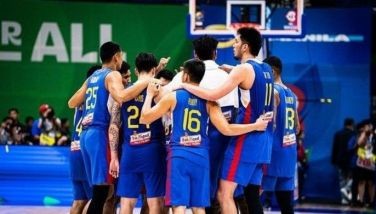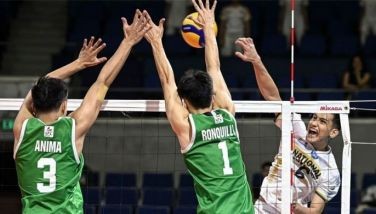Brazilian Jiu-jitsu
July 15, 2002 | 12:00am
Imagine a guy barely weighing 135 pounds beating a 300-pounder in an individual hand-to-hand combat.
It sounds ludicrous but the small guy that just thumped off his bigger foe just happens to know a martial art that is slowly but surely gaining a cult following in the country today – Brazilian or Gracie Jiu-jitsu.
Four of the art’s major proponents – Alvin Aguilar, Fritz Rodriguez, Raffy Garcia and Francisco Garcia – are one in saying that Jiu-jitsu is one of the more effective modes in the field of martial arts today because it’s a technique where size, strength, sex and age are not important.
Eight years after it was introduced in RP, Jiu-jitsu, named after a man who popularized it back in Brazil in the early part of the 19th century, is a form of martial art used to subdue an attacker with the right chokes and locks.
And for starters, Jiu-jitsu, a unique ground fighting art similar to wrestling, can also disable a person permanently. It can also kill. But in spite of these, the art can also be played as a sport.
Unknown to many, Deftac, through Rodriguez, Aguilar, and the two Garcias have been undergoing a rigid training program under a known Brazilian coach in preparation for the World Jiu-jitsu Championships in Rio de Janiero, Brazil July 25-28.
"We’ve invited Brazilian coach Kazeka Muniz to help us train in preparation for the World Championship," said Rodriguez, who left with Aguilar for Brazil Saturday.
"We know it’s going to be tough especially against the Brazilians but we’ll give it our best shot and hope for the best," added Rodriguez.
To date, Aguilar, a businessman and a commercial model on the side, Rodriguez and Muniz have conducted a series of seminars, attracting about 300 aspirants of different ages, sexes and regions in the country.
"We’re not just actually training for competitions abroad, we are also organizing seminars to promote jiu-jitsu with help of Muniz, who is here in the country for a brief period," said Aguilar.
Aguilar has even trained in Ternate, Cavite some American soldiers who are part of the Balikatan in Luzon.
"Basically, I was given a chance to teach the American soldiers in Balikatan in Luzon some jiu-jitsu techniques, mostly involving knife-fighting styles," said Aguilar.
Also in Deftac’s itinerary is the plan to hold an open tournament, or popularly known as the ultimate fighting in martial arts where the best of other arts – taekwondo, karate, judo, boxing, kickboxing, sumo wrestling, pencak silat, etc. – participate.
It’s the ultimate streetfighting just like in the movies.
"It’s still in the works and we’re planning to hold it possibly in October," said Raffy Garcia, a senior Ateneo High School student.
Ultimate fighting began in America on November 12, 1993 when Royce Gracie, a descendant of jiu-jitsu pioneer Carlos Gracie, rose from obscurity to become the event’s first champion.
Royce’s ascent to stardom created major changes in the field of martial arts, carrying with him into popularity the sport and causing people to drop traditional stand-up arts such as karate and kung fu.
It was in Royce’s success that the world realized that a small but very wise and powerful striker could defeat a bigger opponent whose knowledge is tunneled at only one technique.
Thanks to Royce, he has institutionalized the latest craze of combining one or two arts into Jiu-jitsu called mixed martial arts.
"You don’t need to be an expert in one form, you just learn the basics and apply it to make the Jiu-jitsu fighter more effective," said Rodriguez. "It offers the practitioner a much wider arsenal of tools for defense."
Taking a closer look at jiu-jitsu’s history – everything started from Carlos Gracie, who is incidentally a man barely weighing 135 pounds.
Legend has it that Carlos Gracie had won every open challenge he participated in, a tradition he passed on to his brothers, sons and nieces, who in turn, taught their sons down to today’s popular three-time ultimate fighting champ Royce Gracie.
Carlos originally tried the traditional Japanese jiu-jitsu, said to be the mother of all modern forms of martial arts, under the tutelage of the great Japanese champion Mitsuyo Maeda, popularly called in Brazil as Conde Koma or the Count of Combat.
Gracie then tailored the classical techniques he learned from his teacher to the demands of the real, "no rules" fighting in the streets of Brazil, making jiu-jitsu more effective.
From there, the sport had gained immense success in Brazil, making Jiu-jitsu one of the most popular martial arts in the soccer-loving, Portuguese-speaking nation.
Rodriguez, however, warns that Jiu-jitsu is not about force and violence. It is completely about self-defense.
"On the outside, jiu-jitsu appears violent but in the inside, it is not," said Rodriguez. "Jiu-jitsu is actually about making a potential fight less violent if you know the basic techniques such as knowing the weak points of your adversary and knowing when to strike."
For more information about Jiu-jitsu, interested parties may inquire at Deftac located at the ground floor of Emmanuel House, 115 Aguirre St., Legaspi Village, Makati City with tel. nos. 817-0541 and 726-1980. Or you can e-mail Deftac at [email protected].
It sounds ludicrous but the small guy that just thumped off his bigger foe just happens to know a martial art that is slowly but surely gaining a cult following in the country today – Brazilian or Gracie Jiu-jitsu.
Four of the art’s major proponents – Alvin Aguilar, Fritz Rodriguez, Raffy Garcia and Francisco Garcia – are one in saying that Jiu-jitsu is one of the more effective modes in the field of martial arts today because it’s a technique where size, strength, sex and age are not important.
Eight years after it was introduced in RP, Jiu-jitsu, named after a man who popularized it back in Brazil in the early part of the 19th century, is a form of martial art used to subdue an attacker with the right chokes and locks.
And for starters, Jiu-jitsu, a unique ground fighting art similar to wrestling, can also disable a person permanently. It can also kill. But in spite of these, the art can also be played as a sport.
Unknown to many, Deftac, through Rodriguez, Aguilar, and the two Garcias have been undergoing a rigid training program under a known Brazilian coach in preparation for the World Jiu-jitsu Championships in Rio de Janiero, Brazil July 25-28.
"We’ve invited Brazilian coach Kazeka Muniz to help us train in preparation for the World Championship," said Rodriguez, who left with Aguilar for Brazil Saturday.
"We know it’s going to be tough especially against the Brazilians but we’ll give it our best shot and hope for the best," added Rodriguez.
To date, Aguilar, a businessman and a commercial model on the side, Rodriguez and Muniz have conducted a series of seminars, attracting about 300 aspirants of different ages, sexes and regions in the country.
"We’re not just actually training for competitions abroad, we are also organizing seminars to promote jiu-jitsu with help of Muniz, who is here in the country for a brief period," said Aguilar.
Aguilar has even trained in Ternate, Cavite some American soldiers who are part of the Balikatan in Luzon.
"Basically, I was given a chance to teach the American soldiers in Balikatan in Luzon some jiu-jitsu techniques, mostly involving knife-fighting styles," said Aguilar.
Also in Deftac’s itinerary is the plan to hold an open tournament, or popularly known as the ultimate fighting in martial arts where the best of other arts – taekwondo, karate, judo, boxing, kickboxing, sumo wrestling, pencak silat, etc. – participate.
It’s the ultimate streetfighting just like in the movies.
"It’s still in the works and we’re planning to hold it possibly in October," said Raffy Garcia, a senior Ateneo High School student.
Ultimate fighting began in America on November 12, 1993 when Royce Gracie, a descendant of jiu-jitsu pioneer Carlos Gracie, rose from obscurity to become the event’s first champion.
Royce’s ascent to stardom created major changes in the field of martial arts, carrying with him into popularity the sport and causing people to drop traditional stand-up arts such as karate and kung fu.
It was in Royce’s success that the world realized that a small but very wise and powerful striker could defeat a bigger opponent whose knowledge is tunneled at only one technique.
Thanks to Royce, he has institutionalized the latest craze of combining one or two arts into Jiu-jitsu called mixed martial arts.
"You don’t need to be an expert in one form, you just learn the basics and apply it to make the Jiu-jitsu fighter more effective," said Rodriguez. "It offers the practitioner a much wider arsenal of tools for defense."
Taking a closer look at jiu-jitsu’s history – everything started from Carlos Gracie, who is incidentally a man barely weighing 135 pounds.
Legend has it that Carlos Gracie had won every open challenge he participated in, a tradition he passed on to his brothers, sons and nieces, who in turn, taught their sons down to today’s popular three-time ultimate fighting champ Royce Gracie.
Carlos originally tried the traditional Japanese jiu-jitsu, said to be the mother of all modern forms of martial arts, under the tutelage of the great Japanese champion Mitsuyo Maeda, popularly called in Brazil as Conde Koma or the Count of Combat.
Gracie then tailored the classical techniques he learned from his teacher to the demands of the real, "no rules" fighting in the streets of Brazil, making jiu-jitsu more effective.
From there, the sport had gained immense success in Brazil, making Jiu-jitsu one of the most popular martial arts in the soccer-loving, Portuguese-speaking nation.
Rodriguez, however, warns that Jiu-jitsu is not about force and violence. It is completely about self-defense.
"On the outside, jiu-jitsu appears violent but in the inside, it is not," said Rodriguez. "Jiu-jitsu is actually about making a potential fight less violent if you know the basic techniques such as knowing the weak points of your adversary and knowing when to strike."
For more information about Jiu-jitsu, interested parties may inquire at Deftac located at the ground floor of Emmanuel House, 115 Aguirre St., Legaspi Village, Makati City with tel. nos. 817-0541 and 726-1980. Or you can e-mail Deftac at [email protected].
BrandSpace Articles
<
>
- Latest
- Trending
Trending
Latest
Trending
Latest
Recommended





























